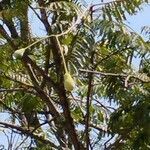Tree to 35(-45) m high. Leaves alternate, primary rachis including petiole (11—)21—34(—45) cm long. Gland on petiole single, elliptical, midway between base and 1st pair of pinnae, c. 1-3 cm from base; smaller circular glands on primary rachis between ultimate pair(s) of pinnae. Pinnae ll-20(-25) pairs, opposite or subopposite, rachis (3.5-)6-9(-10) cm long; leaflets (18-)29-42 pairs, ± oblong, (3-)5-10(-12) by (l-)1.5-2(-3) mm, margins of adjacent ones contiguous or overlapping, glabrous or with a few hairs around the margin; apex rounded, base strongly auriculate on proximal side; main nerve central, straight at apex or slightly sigmoid. Peduncles 4-10 per compound inflorescence reaching maturity, alternate, 7-57 cm long. Capitula 5.4-6.7 cm long, somewhat biglobose at anthesis with central constricted nectar-secreting region c. 2.5 cm in diameter, the basal staminodial region somewhat broader, and the apical fertile part elliptical to ovate, 3.2-4.2 cm in diameter, or less in dried material. Flowers bisexual. Calyx 6.5-9.5 mm long, including pseudopedicel of 1.5-2 mm, and the largest lobes 1-1.5 mm long; corolla 7.5-10 mm long, the lobes pubescent on outer surface, 1-1.5 mm long, then fused below for 1-3 mm, and free below; filaments exserted 2-4.5 mm beyond calyx, and united to 5-8.5 mm from base. Pods strap-shaped, usually twisted, the valves coriaceous, conspicuously swollen over, and indented between the seeds, glabrous, the veins prominent and forming a reticulate network, c. 20-40 by 2-4.9 cm, gradually attenuate at base into a narrow stipe 3-13.5 cm long. Seeds c. 18 per pod, elliptical or broadly elliptical in outline, lying horizontal or obliquely horizontal across the width of the pod, up to 23 mm long, foul smelling; testa green, softish.
More
A tree. It can grow 35-45 m high. It can spread 8-15 m wide. The trunk can be 1 m across. It can have buttresses. The leaves occur alternately along the stalk. The leaf and leaf stalk can be 21-40 cm long. There is a single gland on the leaf stalk about half way between the base and the first pair of leaflets. It is about 1-3 cm from the base. There are also small circular lands near the last leaflets. There are 11-20 or 25 pairs of leaflets. These are 5-10 cm long by 1-2 cm wide. The edges of nearby leaflets overlap. The tip of the leaflet is rounded and the base is expanded around the stem on one side. The flower stalks are 7-57 cm long and hang down on the tree. On the end of these are 4-10 flowers crowded together and then pods develop. Flowers contain both sexes. The pods are strap shaped and usually twisted. The pods are swollen over the seeds and constricted between the seeds. The pods are 20-40 cm long by 2-5 cm wide. There are about 18 seeds per pod. They lie across the width of the pod. They are up to 23 mm long. They have a strong smell. The seed coat is soft and green.
An emergent tree in undisturbed lowland rainforests and sometimes also in tall secondary forest, on sandy, loamy and podzolic soils, also in waterlogged locations, in freshwater swamp forest and on riverbanks.
More
A tropical plant. It is native to SE Asia. They grow in lowland rainforest. It suits a humid climate. They are mostly between sea level and 900 m altitude. It suits hardiness zones 11-12.
Uses The mature green seeds are eaten avidly but in small quantities in Peninsular Malaya and Indonesia as a flavouring in stews. They are sold fresh as bunches of pods in markets, and as pods or loose seeds, either fresh or tinned, in supermarkets. They have a strong, distinctive and disagreeable odour and flavour, reminiscent of bad onions or garlic, and are said to make those who consume thrm smell also (Burkill I.c.; Heyne I.c.); they ai said to have a diuretic and relaxing effect. \ oung pods are also sometimes cooked as a vegetable, and young seeds may be eaten pickled, raw or cooked. Young leaves and the fleshy part of the receptacle are also reported as edible. The pods are reported as containing some edible pulp (e.g. Hunter I.c.; Burkill I.c.), but if so, the quantity is very much less than in the African P. biglobosa. The seeds are used medicinally against liver disease, diabetes, and worms.
More
The seeds are used as flavouring stews. Dried seeds are peeled and fried in oil. Young pods are eaten cooked as a vegetable. They are eaten with poultry, fish or stir-fried vegetable dishes. Young seeds can be eaten pickled, raw or cooked. They are roasted, boiled or added to soups. Young leaves are also eaten raw. They are packed in brine. The receptacle around the flowers is cut into slices and eaten raw.


